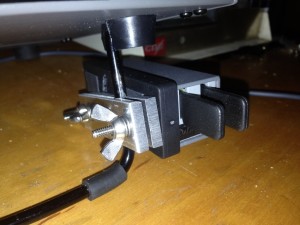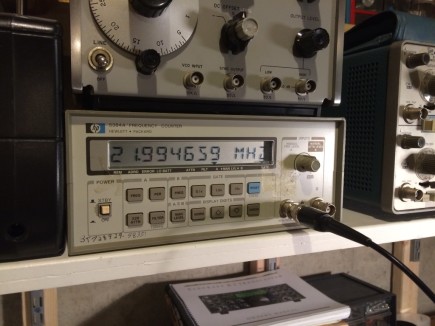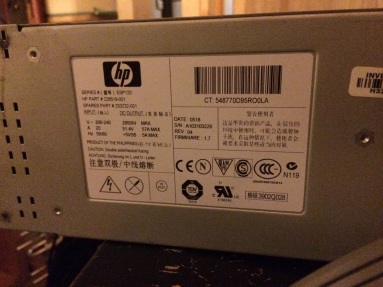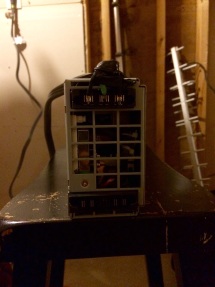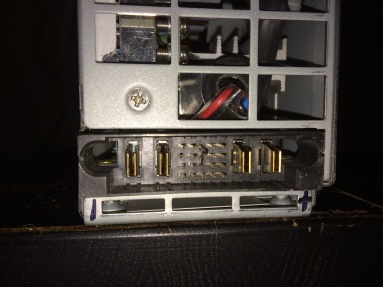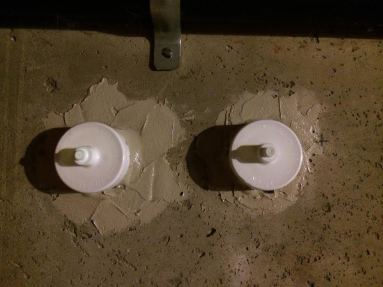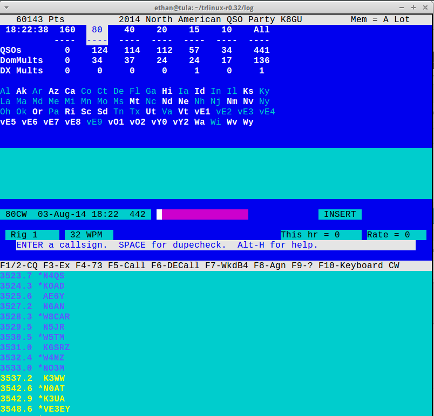Posts Tagged ‘joy of homebrew’
 Making the Palm Mini Paddle Stay Put
Making the Palm Mini Paddle Stay Put
In my on-going quest to produce a lightweight yet good-performing kit of portable equipment to carry along on my exotic work travels, I set my sights once again upon the Morse keying paddles. When I was a student, I carried what I had: a black-base Bencher BY-1. This caught the attention of nearly every airport security screener and was obviously quite heavy, but it stayed put on the table (for the most part) when I aggressively worked a pileup. A few years back, my wonderful, loving, and patient wife, solicited suggestions for Christmas gifts and I suggested a Palm Radio Mini Paddle. (She’s grateful when I provide a link to a web site with a shopping cart in these situations.)
The Palm is really a joy to use and is extraordinarily lightweight, which is perfect for travel. However, I’ve always struggled with how to keep it steady on a table. I have the magnetic base, but that presupposes a ferromagnetic surface to which it will mount. Since both the Elecraft K3 and K2 have aluminum panels, I can’t count on the radio. I tried a variety of additional things, up to and including, trying to design a 3D-printed carrier that is akin to the Begali Traveler. So, I shelved the project, only using the Palm key for casual portable operating when mass trumped long-term operating comfort and efficiency. Good fortune happened upon me and I built this.
When I decided to add an amplifier (more on this in the future) to my portable setup, again pressure set in on the mass of everything. So, I revisited the Palm Mini project. I had purchased a number of mounting clips for the key (hedging my bets against the ephemeral nature of ham radio businesses); so, I set out to attach one to the K2. I’d seen the photo of the base attached to the right-hand side panel of the K2 by the power switch. But, I really didn’t want to drill holes in the panel, plus that puts the paddles too high when the tilt bail is raised (which is necessary to see the display).
So, I fabricated two strips of 3/16-inch aluminum plate (leftover from the hexagonal beam I built a few years ago) with a hole bored down between them to clamp on the tilt bail of the K2 or the K3. There’s nothing particularly critical about the construction of it, although I used a Bridgeport mill to do all the cutting; you might be able to do it in a drill press. I think I ended up with a #14 drill for the clamp hole. I used 6-32 hardware because I had it on-hand and I like the bigger stuff. I had to enlarge the adjustment slot in the Palm base to handle the bigger diameter.
 50-MHz transverter update (Psst! Newark has cheap 22-MHz crystals)
50-MHz transverter update (Psst! Newark has cheap 22-MHz crystals)
A few years ago, I built a 50-MHz transverter to operate 6m with my Kenwood TS-930Ses. I subsequently replaced the two 930s with an Elecraft K3/100 and Elecraft K2/100. The K3 has 6m and I sold off my TS-700S (and my 6m Mirage brick amplifier) to help finance the internal 2m board for the K3. The problem with this arrangement is that I can’t be on 6m and 2m at the same time. I recently assembled and added the SSB board and transverter interface to my K2 (no time to blog about this but they were straightforward additions like everything from Elecraft), now making it an attractive IF for the 6m transverter (and the Microwave Modules 432 transverter I have on the shelf and the 222-MHz transverter I plan to build sometime).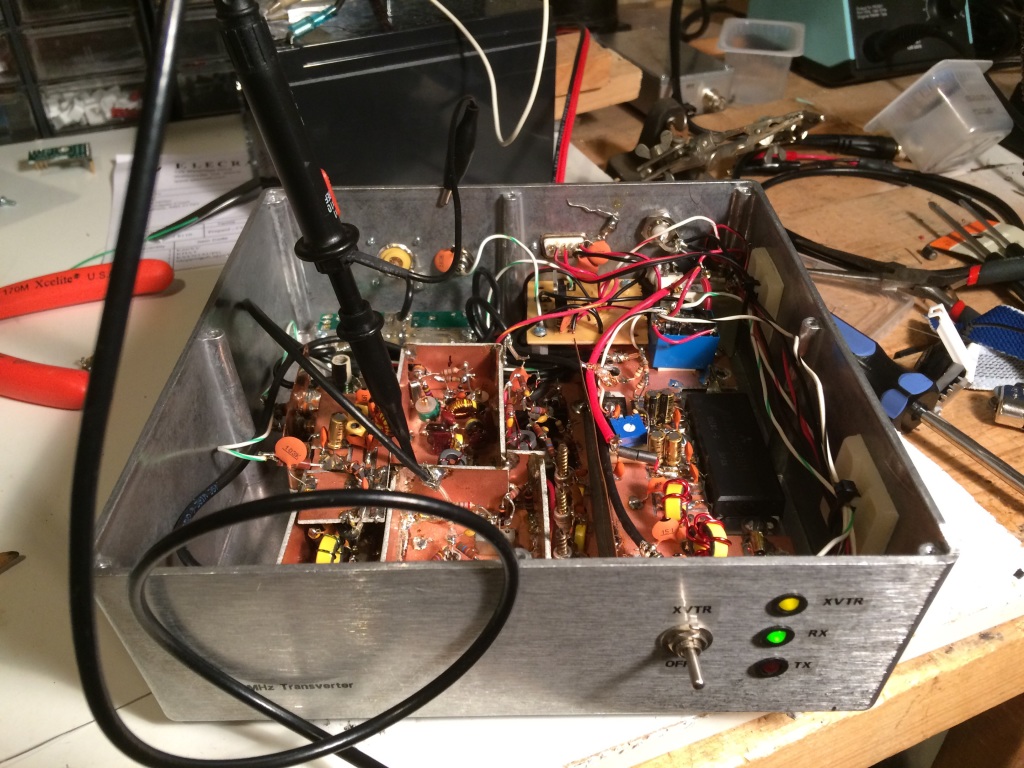
Enter the problem: Because I was thrifty about building the transverter at first, I had used an inexpensive and widely-available 24-MHz crystal for a 26-MHz IF. The TS-930S happily worked here (by the way, pro-tip: A lot of guys say that they liked to have the wideband transmit mods on their HF rigs so they could have a wideband signal source for testing/transverters/etc. The TS-930S will give you a low-level TX out anywhere through the transverter port, even if you don’t have the mod. Well, at least my PIEXX-equipped 930 did). However, the K2 only allows a select set of transverter IF bands to be used natively. Good fortune shone upon my endeavors when I did a quick Google search for 22-MHz crystals and one actually popped up at Newark/Element14 (part number is 86R1720, get ‘em while they’re hot)! Even better news was that it was on closeout for 12 cents apiece! I splurged and bought five, along with some other parts for another project or two I’ll post about eventually.
I carefully peeled back a layer of dead-bug components, extracted the 24-MHz crystal, and replaced it with the new 22-MHz variety, sacrificing only one 4.7-k resistor, an easily-replaced stock item at K8GU. The LO came up about 5.4 kHz low and I couldn’t peak it any higher. So, I’ll either have to futz around with the loading of the crystal or (more likely) load an offset in the K2’s transverter band entry for 6m.
The local W3APL beacon popped up at 28.0694 MHz, which is consistent with the offset I observed above. Now, I just have to get the other interfacing juju worked out to get the K2 to properly command the transverter to transmit and feed it the proper drive level.
 Converting the HP ESP120 Power Supply
Converting the HP ESP120 Power Supply
Quick notes on converting the HP ES120 2950-watt blade server power supply to run “48-volt” amateur radio amplifiers. The power supply I have has a slightly different in configuration from the one described by W8ZN on the K8GP site.
I picked up the power supply on good terms at Dayton some years ago and finally managed to get around to hooking it up after I put two 240-volt, 20-amp circuits in my shack this spring/summer. I used a molded air conditioner extension cord with the female end cut off to attach it to the wall. Hot-ground-hot is the wiring on the AC input side. On the output, there is a jumper block and two pairs of blade connectors, with one pair being positive and the other negative, strapped together. In the middle of the output there is a jumper block.
Here is where the steps differ from the W8ZN steps: instead of shorting two pairs of pins together, this power supply requires three in a line to be shorted together. It’s visible in the photo below, I think. The center row.
I’m getting 51.4 volts unloaded. Load will be described in the future as it comes to be…
 Notes and Ramblings
Notes and Ramblings
Three perhaps noteworthy amateur radio activities occurred recently around K8GU: 1. During the course of some HVAC upgrades, I was able to get two holes core drilled through the foundation to bring coax and control cables into the house; 2. I operated in the NAQP August CW contest; 3. Evan and I went to the Berryville, VA, hamfest.
These two ports exit the basement into a crawl space where I will ground the cables before they enter the house. I still need to get some hydraulic cement or other quick-setting patch mortar to clean up the drill crater on the outside. Total cost: $5 in materials and a large pizza for the crew.
Screenshot above shows TRLinux after the end of the contest (obviously it was today, not last night). TRLinux performed flawlessly again with the YCCC SO2R+ box driving the KK1L band-decoder and 6×2 switch. I operated for about five hours (probably a little more, and definitely more if I used the NAQP 30-minute time-off rule to calculate it). I got up after my first operating sitting at the beginning of the contest and left the shack. As I exited the door, I was hit with the smell of hot electronics. You know the smell: like when you just let the smoke out of a transistor. I walked over to the antenna switch matrix where I was using a triplexer to split the hexagonal beam to both radios. It was warm to the touch. It seems to have continued to function, but I’ll have to disassemble it at some point to see if any irreversible damage was done.
The August NAQPs are always fun for us out East because there is the ever-present opportunity for sporadic-E throughout the contest, giving us a chance to work nearby states, which can really drive up the multiplier (and QSO, depending on the direction of the opening) total. Of course, this is the real boon of having a second radio: you can call CQ on your most productive band while looking for openings on the others. I came down after supper with the family to “work 40 meters before it goes long” and ended up with blistering 10- and 15-meter runs into the Midwest and South. Since Evan and I were planning to go to the hamfest and I don’t yet have a 160-meter antenna at the “new” QTH, I pulled the plug at midnight local time (0400). Not sure 40 meters was even getting long at that point. At any rate, it was wonderful to say “hi” to so many old friends from MRRC, MWA, SMC, PVRC, and beyond!
A final comment: You can really tell how much better one radio is than another when you have them both side-by-side on your desk. This was quite apparent when I had the K3 and the TS-930S and it is also apparent with the K3 and the K2. The K2 is a wonderful radio and fun to operate, especially in the field, but it’s not the K3 as far as fit and finish, among other things. No, I’m not buying another K3 anytime soon. The K2 is quite enough for the second radio.
I’ve always heard that the Berryville, VA, hamfest had a good boneyard/fleamarket/swapmeet but I’ve never managed to attend. I resolved to attend this year and was pleasantly surprised. Evan came along for the ham-and-egg breakfast, which was good but he rejected the ham after only consuming about 1/3 of it, and a trip to the playground at the school across the road. This is still a “real” hamfest like the ones I remember going to in the early 1990s before eBay and online trading really took the wind out of swapmeets. There were plenty of rigs spanning the spectrum of boatanchor to relatively modern, HF and VHF/UHF. There were lots of amplifiers, as well, (and a small quantity of CB junk; Texas Star, anyone?) There were also lots of antennas, and even some Rohn 25. The computer and cell phone accessory dealers were mercifully few and there were lots of tables of parts, bits and pieces. This is a ham’s hamfest and I’ll be returning. I picked up a bunch of Cinch-Jones plugs and sockets for my new cable ingress, plus some SMA connectors and flexible coax jumpers. Plus, I ran into a few friends, although not the ones I expected to see!
 More paddle work
More paddle work
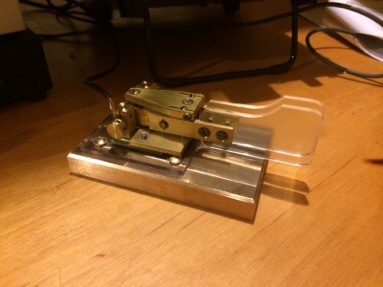
Over the past couple of weeks, I’ve managed to steal away to the machine shop and continue to work on mounting the Schurr Einbau mechanism. I found a piece of polycarbonate in my scrap bin to make the interface between the Einbau and the base. It turned out that the mounting holes are tapped M3-0.5 so I had to make trip to Ace. While I was there, I picked up some brass screws also. Total cost of the project is 52.99 USD. I bored the holes in the base today with the milling machine and tapped them when I got home. Couldn’t resist putting it all together even though I haven’t finished polishing the base or the polycarbonate plate…
 Paddle project
Paddle project
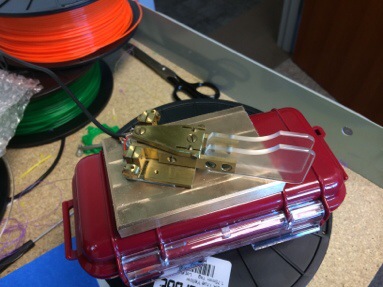
Over the years, I’ve fancifully imagined that I would build a set of keyer paddles. I even went so far as designing a couple concepts and collecting materials…but, inevitably I moved on from the institution with the machine shop and sucker machinist who was showing me the ropes. About a week ago, Mike, W3MC, posted a bunch of goodies for sale, including a Schurr Einbau key mechanism. Since I love my Profi 2, I snapped it up, recalling also that I had a nice hunk of brass for a base. Today, I cut and milled a little base for it. Lots of finishing and some acrylic work remain, but for now, there’s something special about a freshly-milled hunk of metal.
